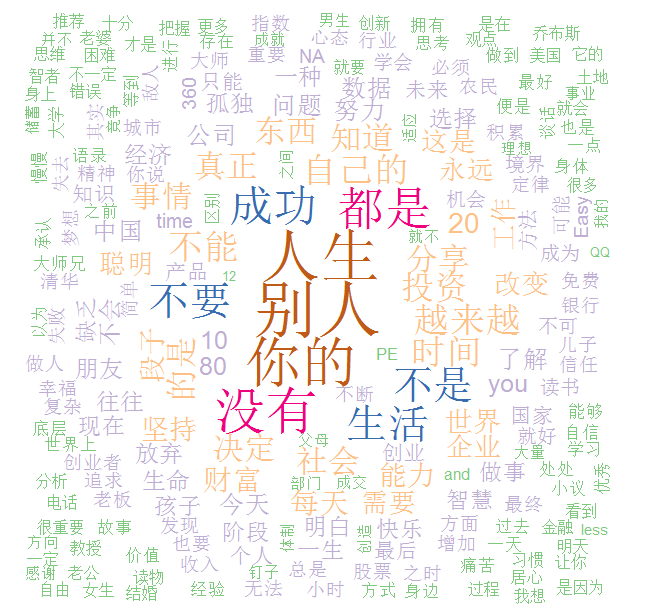分析过程中需要用到的R包:Rweibo、 Rwordseg(或者rsmartcn)、wordcloud。
根据个人情况,下载了以下搜狗细胞词库:
“统计学名词”、“数学词汇大全”、“机器学习”、“财经金融词汇大全”、“互联网词库(2006版)”、“哈工大停用词表扩展”
1、加载Rweibo包,进行授权申请。其中"key"与“Secret”需要通过开通新浪开发者账号获得,具体过程和细节可以看Rweibo包中的help文档。
library(Rweibo) registerApp(app_name = "Jonee", "key", "Secret") roauth <- createOAuth(app_name ="Jonee", access_name = "Rweibo")
2、抓取个人微博的全部信息
Allwb <- analysis.getUserTimeline(roauth, screen_name = "Jonee-SH") nrow(Allwb)
输出结果:327,说明一共发了327条微博。
3、查看自己原创微博数量占总微博数的百分比:
sum(is.na(Allwb$retweeted_text))/nrow(Allwb)*100
结果: 3.058104%
可以看出自己基本上都是转发的别人的微博,基本上不自己写微博,这也跟自己把微博当成信息媒介而非社交网络有关。有鉴于此,后面的关键词分析将包含自己所转发的内容,以此来探索自己主要关注什么内容。
4、数据预处理
在转发别人微博的时候,往往已经有人做了评论或者转发,因此会包括“//@”、“@”、“:”等字符以及别人的微博名,所以需要做一下预处理:
text_clean=unlist(lapply(Allwb$text,strsplit,split="//@",perl=T)) clean=lapply(text_clean,gregexpr,pattern=":",perl=T) omit=unlist(lapply(clean,function(x) x[[1]][1])) locate=which(omit>0) temp.text=text_clean[locate] text_clean[locate]=substr(temp.text,omit[locate]+1,max(nchar(temp.text))+1)
5、利用Rwordseg包来做分词。
因为Rwordseg包支持导入搜狗细胞词库,结合个人情况,我在这里导入“统计学名词”、“数学词汇大全”、“机器学习”、“财经金融词汇大全”、“互联网词库(2006版)”五个词库。
library(Rwordseg) installDict("SogouLabDic.dic", dictname = "SogouLabDic.dic", dicttype = c("text")) installDict("统计学名词.scel", dictname = "stat.scel", dicttype = c("scel")) installDict("数学词汇大全.scel", dictname = "math.scel", dicttype = c("scel")) installDict("机器学习.scel", dictname = "machine_learning.scel", dicttype = c("scel")) installDict("财经金融词汇大全.scel", dictname = "financial.scel", dicttype = c("scel"))
输出结果:
157202 words were loaded! ... New dictionary 'SogouLabDic.dic' was installed!
625 words were loaded! ... New dictionary 'stat.scel' was installed!
15764 words were loaded! ... New dictionary 'math.scel' was installed!
9 words were loaded! ... New dictionary 'machine_learning.scel' was installed!
11319 words were loaded! ... New dictionary 'financial.scel' was installed!
可以看出,“互联网词库”的词组最多,将近16万,“机器学习”的最少,才9个。
进行分词:
retweet_text=unlist(Allwb$retweeted_text) text.final=c(text_clean,retweet_text) segment.options(isNameRecognition = TRUE) text.seg=unlist(segmentCN(text.final)) text.seg=text.seg[text.seg!=""]
6、去噪音。
这里只是简单的去掉词长仅为1的单个字,并且删掉一些没有实际含义但出现频率较高的词组(需要用到“哈工大停用词表扩展”)。
处理方式如下:
text.seg=text.seg[nchar(text.seg)>1] text.table=table(text.seg) word=names(text.table) stopwords=readLines("哈工大停用词表扩展.txt") stopwords=c(stopwords,"http","cn","www",“net”,"com") word=setdiff(word,stopwords) word <- word[word != '转发'] word <- word[word != '微博'] word <- word[word != '的人'] text.table=text.table[word]
7、结果展示(最小频数设为5,将调色板中第四种颜色(亮黄色)去掉,过于刺眼):
library(wordcloud) pal <- brewer.pal(7,"Accent") pal <- pal[-(4)] wordcloud(word, text.table,min.freq=5,random.order=FALSE, colors=pal)
结果如下:
